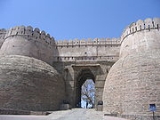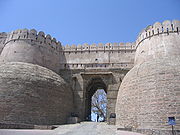
Kumbhalgarh
Encyclopedia


Mewar
Mewar is a region of south-central Rajasthan state in western India. It includes the present-day districts of Pratapgarh, Bhilwara, Chittorgarh, Rajsamand, Udaipur, Dungarpur, Banswara and some of the part of Gujarat and Madhya Pradesh. The region was for centuries a Rajput kingdom that later...
fortress in the Rajsamand District of Rajasthan
Rajasthan
Rājasthān the land of Rajasthanis, , is the largest state of the Republic of India by area. It is located in the northwest of India. It encompasses most of the area of the large, inhospitable Great Indian Desert , which has an edge paralleling the Sutlej-Indus river valley along its border with...
state in western India
India
India , officially the Republic of India , is a country in South Asia. It is the seventh-largest country by geographical area, the second-most populous country with over 1.2 billion people, and the most populous democracy in the world...
. Built during the course of the 15th century by Rana Kumbha, and enlarged through the 19th century, Kumbhalgarh is also a birthplace of Maharana Pratap, the great king and warrior of Mewar. Occupied until the late 19th century, the fort is now open to the general public as a museum and is spectacularly lit for a few minutes each evening. Kumbalgarh is situated 82 km from Udaipur
Udaipur
Udaipur , also known as the City of Lakes, is a city, a Municipal Council and the administrative headquarters of the Udaipur district in the state of Rajasthan in western India. It is located southwest of the state capital, Jaipur, west of Kota, and northeast from Ahmedabad...
towards its northwest and is easily accessible by road. It is the most important fort in Mewar after Chittaurgarh.
Construction
Built on a hilltop 1100 metres above sea level, the fort of Kumbhalgarh has perimeter walls that extend 36 kilometres. The frontal walls are fifteen feet thick. Kumbhalgarh has seven fortified gateways. There are over 360 temples within the fort, 300 ancient Jain and the rest HinduHindu
Hindu refers to an identity associated with the philosophical, religious and cultural systems that are indigenous to the Indian subcontinent. As used in the Constitution of India, the word "Hindu" is also attributed to all persons professing any Indian religion...
. From the palace top, it is possible to look tens of kilometers into the Aravalli Range
Aravalli Range
The Aravalli Range literally meaning 'line of peaks', is a range of mountains in western India and eastern Pakistan running approximately 800 km from northeast to southwest across states of Rajasthan, Haryana, and Gujarat and Pakistani provinces of Punjab and Sindh...
. The sand dunes of the Thar desert can be seen from the fort walls.
According to legend, in 1443, the Maharana of Kumbhalgarh, Rana Kumbha, was initially repeatedly unsuccessful in attempts to build the fort wall. A spiritual preceptor was consulted about the construction problems and advised the ruler that a voluntary human sacrifice would solve whatever was causing the impediment. The spiritual advisor advised building a temple where the head should fall, and to build the wall and the fort where the rest of his body lay. As can be expected, for some time no one volunteered, but one day, a pilgrim, or some versions suggest a soldier, and some the spiritual preceptor and the pilgrim were one and the same, volunteered and was ritually decapitated. Today the main gate of the fortress, Hanuman Pol, contains a shrine and a temple to commemorate the great sacrifice.
According to popular folklore, Maharana Kumbha used to burn massive lamps that consumed fifty kilograms of ghee
Ghee
Ghee is a class of clarified butter that originated in South Asia and is commonly used in South Asian cuisine....
and a hundred kilograms of cotton to provide light for the farmers who worked during the nights in the valley.
History
The Kumbhalgarh was built and ruled by Kumbha and his dynasty who were Sisodia descendents.Kumbhalgarh in its present form was developed by, and said to be personally designed by Rana Kumbha. Rana Kumbha's kingdom of Mewar stretched from Ranthambore to Gwalior and included large tracts of erstwhile Madhya Pradesh
Madhya Pradesh
Madhya Pradesh , often called the Heart of India, is a state in central India. Its capital is Bhopal and Indore is the largest city....
as well as Rajasthan. Out of the 84 forts in his dominion, Rana Kumbha is said to have designed 32 of them, of which Kumbhalgarh is the largest and most elaborate.
Kumbhalgarh also separated Mewar and Marwar
Marwar
Marwar is a region of southwestern Rajasthan state in western India. It lies partly in the Thar Desert. In Rajasthani dialect "wad" means a particular area. The word Marwar is derived from Sanskrit word 'Maruwat'. English translation of the word is 'The region of desert'., The Imperial Gazetteer...
from each other and was used as a place of refuge for the rulers of Mewar at times of danger. A notable instance was in the case of Prince Udai, the infant king of Mewar who was smuggled here in 1535, when Chittaur was under siege. Prince Udai who later succeeded to the throne was also the founder of the Udaipur City. The fort remained impregnable to direct assault, and fell only once, due to a shortage of drinking water, to the combined forces of Mughal Emperor Akbar, Raja Man Singh of Amber, Raja Udai Singh of Marwar, and the Sultan of Gujarat.
See also
- Kumbhalgarh Wildlife SanctuaryKumbhalgarh Wildlife SanctuaryKumbhalgarh Wildlife Sanctuary is in the Rajsamand District of Rajasthan state in western India and surrounds the Kumbhalgarh fortress and covers an area of 578 km²...
- MewarMewarMewar is a region of south-central Rajasthan state in western India. It includes the present-day districts of Pratapgarh, Bhilwara, Chittorgarh, Rajsamand, Udaipur, Dungarpur, Banswara and some of the part of Gujarat and Madhya Pradesh. The region was for centuries a Rajput kingdom that later...
- Rana Kumbha
- Maharana Pratap

